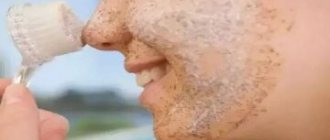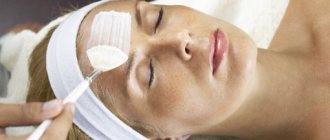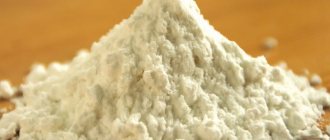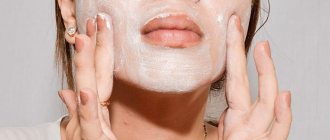Peeling, or exfoliation, is needed to ensure regular exfoliation of the top layer of the skin, to renew the epidermis and free it from dead cells. If you delicately help your skin cleanse of this unnecessary “ballast”, then you can keep it in a fresh, young, “rested” state for a long time.
In addition, lemon peeling for the face at home makes sense for those who want to get rid of excess oil in certain areas of the facial skin; remove the characteristic greasy shine; clean clogged and enlarged pores; whiten and make age spots and (or) freckles less noticeable.
As a means to cleanse and renew the skin, you should use slices of fresh lemon, or its juice, in combination with other additional ingredients, which will be discussed below. But synthetic citric acid, which is sold in powdered packaged form, is not meant at all here - it’s still not worth using.
The principle of action and effectiveness of lemon peeling
In many countries around the world, lemon peeling is a simple way to free the skin from impurities in the form of clogged pores and sebaceous plugs. Lemon juice is also valued for its ability to improve complexion, whiten blemishes and hide other minor skin imperfections. Overall, skin treated with lemon juice appears fresh, rested and rejuvenated.
This natural acid peeling has the following operating principle. Citric acid has a loosening effect on the upper layer of the epidermis and cleanses it of dirt particles that have formed in the pores from mixing sebum with dust, as well as dead “waste” cells. In addition to dissolving sebaceous and dirty plugs, acid has the property of narrowing pores and tightening the oval of the face.
In addition to citric acid, citrus juice and pulp contain a fair amount of bioflavonoids rutin (vitamin P) and hesperidin. These substances increase the strength and elasticity of capillaries, entering the deeper layers of the skin through the pores. Lemon juice contains many phytoncides, pectin substances, theamine and eriocitrin that have beneficial antibacterial and antiseptic properties. They have a whitening effect on age spots, and a smoothing effect on the surface of the skin as a whole. Lemon has no equal in terms of ascorbic acid content!
The result of the procedure is clearly visible shortly after its completion. Facial skin looks fresh, rested, more even and toned. Therefore, lemon peeling has earned the recognition of many for a reason. In addition to fast, high-quality cleansing and refreshing of the skin, it can also be characterized by exceptional ease of implementation and a small number of contraindications.
Indications and contraindications for use
Homemade lemon peeling requires some caution and a clear understanding that it is right for you. So, you can use citrus to cleanse the upper layer of the epidermis in the following cases:
- For tired skin;
- In the presence of clogged pores and impurities;
- For any dysfunction of the sebaceous glands;
- If you have acne;
- If there are signs of wilting;
- Hyperpigmentation and freckles.
But there are certain contraindications for the use of citrus:
- Allergy to citrus fruits;
- Presence of open wounds;
- Severe foci of inflammation.
It is important to consider that lemon should be used very carefully for those with sensitive and extremely dry skin. If, upon first application, the composition begins to burn strongly, the product is not suitable for you.
Are there any contraindications?
Contraindications are as follows:
- Everyone, without exception, when planning a facial peel with lemon at home, needs to make sure that there are no fresh micro-scratches, inflamed pimples and ulcers on the face. Otherwise, discomfort and irritation from the effects of acid cannot be avoided.
- Any procedures with lemon should not be performed by those who are allergic to citrus fruits.
- You should not use this peeling seed in places where spider veins are located close to the surface of the skin.
- Gradually, and only after a partial trial, the procedure can be used for people with very sensitive skin.
- For those with dry skin, acid peeling is not suitable. This product is for normal to oily skin.
Also, after peeling, you should not immediately go out into the sun, especially in summer! In general, you need to remember that citric acid is a rather aggressive substance. Therefore, to begin with, it makes sense to try using lemon peeling on a small area of the face and see how the skin reacts. If there is irritation or even just discomfort, this means this method of cleansing and whitening is not for you.
The best peeling recipes with lemon juice
For the exfoliation procedure, you can and should use not only pure lemon juice and pulp, but also their combinations with additional cosmetics “from what is at hand.” Then the raw material for peeling will also acquire the properties of a mild scrub. Moreover, you can prepare recipes for “lemon peeling plus...” at home very quickly and easily.
The list of the best additional ingredients includes finely grated lemon peel; cucumber; starch; honey; ground coffee. Any of these compositions are applied only to cleansed, makeup-free and pre-moisturized skin. The first time - for 2-3 minutes, with repeated applications - for 5-10 minutes. It would also be a good idea to steam the skin (especially oily skin) before peeling to better open the pores for cleansing. The proportions for each of the above recipes are the same: you need to take approximately equal amounts of lemon juice and an additional ingredient, with a slight predominance of lemon.
- Lemon + cucumber. This combination enhances the whitening and smoothing effect of peeling. To make this homemade facial peeling, you need to grind lemon pulp and cucumber in a blender until smooth. There is also an option to add eggs to this mixture.
- Lemon + honey. You need to mix the lemon juice and thick honey well with a spoon. This type of peeling will help penetrate deeper into the skin pores and clean them even better.
- Lemon + coffee. Ground, moistened coffee (“coffee grounds”) is very often used to prepare various types of facial scrubs, and for good reason. Coffee has a tonic effect on the skin, stimulating it to regenerate and rejuvenate. The mixture turns out thick, slightly “rough” and creaking to the touch. It is applied, unlike “smooth” mixtures, without massaging movements with the fingertips.
- Lemon + starch. What is meant here is not dry starch powder, but brewed with a small amount of hot water into a thick “jelly”. The resulting mixture with lemon is applied to the skin of the face 3-5 times, one layer after another. Everything is individual, but most women who have tried this type of lemon peeling note its tightening properties (“lifting effect”). The face gets rid of sagging and its clear oval returns.
About how to do lemon peeling at home, i.e. What should be the correct technique for applying lemon mixtures, it would not be amiss to ask professional cosmetologists. Read on for a summary of their advice.
Homemade recipes: beauty and health of skin
An incredibly large selection of recipes for peeling and rejuvenating the epidermis with lemon can be found on the Internet. Which one should you choose to achieve maximum effect and not harm yourself?
Lemon to help dry skin
Dry skin is very demanding when it comes to skin care products, so the facial peeling procedure should be very gentle and not cause loss of moisture. We suggest you try the following peeling composition:
- Lemon zest;
- 1 tbsp. oatmeal (or rice) flour;
- 0.5 tsp lemon juice;
- Boiled water.
- Grind the citrus zest.
- Add to 1 tsp. chopped zest flour.
- Pour in warm boiled water until the mixture is homogeneous and easy to apply to the surface of the face.
- For greater effectiveness, you can add fresh lemon juice.
- Mix the peeling product thoroughly and apply to the skin.
- Rinse off after 5-8 minutes, apply cream.
Lemon against oiliness
Peeling with lemon juice is suitable for normalizing the secretions of the sebaceous glands, eliminating oily shine and cleansing pores. The following recipe will help:
- 1 tbsp. natural honey;
- 1 tbsp. low-fat yogurt;
- Half a lemon;
- Egg white.
- 1. Melt honey in a bathhouse until fluid.
- 2. Squeeze the juice out of half a lemon.
- 3. Separate the protein and beat it into foam.
- 4. Mix all ingredients.
- 5. Apply the peeling composition to the surface of the face.
- 6. Rinse off after 10-15 minutes.
- 7. Use nourishing cream.
The secret to a perfect face from England
The following recipe will help you feel like a real queen with perfectly clean and radiant skin:
- Lemon zest;
- 1 tbsp. vegetable oil (preferably olive);
- 1-2 drops of lemon ether.
- 1. Grind the sunny citrus zest as much as possible.
- 2. Add oil and lemon ether.
- 3. Mix the ingredients well.
- 4. Spread the mixture over your face, excluding the periorbital area.
- 5. After 5–10 minutes, rinse off the remaining product and apply cream.
Gentle peeling for sensitive skin
A combination of ingredients will help you easily get rid of dead cells, blackheads, rejuvenate and tighten the epidermis:
- 2 tbsp. oatmeal;
- Lemon juice.
- 1. Grind the cereal in a blender.
- 2. Add citrus juice until the mixture resembles sour cream.
- 3. Spread the mixture on your face.
- 4. After 10 minutes, remove any remaining peeling agent with warm water.
- 5. Apply skincare cream.
Cleansing combination skin
For peeling the combined type of epidermis, a sugar composition is suitable:
- 2 tsp brown sugar;
- Lemon juice.
- 1. Gradually add lemon juice to brown sugar until you reach the consistency of sour cream.
- 2. Apply the nourishing composition to the skin, excluding the area around the eyes and the nasolabial triangle.
- 3. Massage your face for 1-2 minutes.
- 4. After 5 minutes, rinse off the lemon product with water.
- 5. Secure the result with cream.
How to care for your skin after procedures
There is another important point: ensuring skin protection after exposure to acid-fruit peeling. For some time it will become overly sensitive to external influences. In this regard, after you have peeled with lemon juice, you should not immediately go out into the open sun (as already mentioned).
A few minutes after performing acid peeling, it won’t hurt to wipe your face with an ice cube to narrow the cleansed pores. And it is very advisable to nourish it with a small amount of light moisturizer. By the way, there are creams with the property of dissolving “blackheads”. If you no longer use decorative cosmetics until the end of the day, the effect of renewing and refreshing the skin will be the best.
Citric acid in whitening procedures
Home cosmetology experts often call “Limonka” a real panacea for age spots and freckles; special mask compositions are prepared on its basis to help whiten and lighten the skin. Citric acid for cleansing the face of unsightly age spots gives high results due to its high exfoliating qualities.
But is it possible to whiten the dermis of the face with citric acid and not worry about the condition of your skin, because everyone knows the caustic qualities of this substance? Cosmetologists answer this question this way: you can whiten the dermis with lemon, but only in the procedure you should use natural acid contained in lemon juice, and not food powder concentrate.
How to properly whiten your face with citric acid? You need to prepare for the whitening procedure in advance: clean the epidermis with a soft, gentle scrub and thoroughly steam your face.
- Take one large ripe lemon and cut it into two halves.
- Squeeze the juice from each half.
- Pour the juice into a clean container.
- Arm yourself with a sterile cotton gauze swab, soak it in fresh juice and gently wipe the areas of your face that you would like to brighten.
Ladies who want to remove freckles from their skin often ask cosmetologists about the topic - how often can you wipe your face with lemon juice and is it possible to cleanse with citric acid? The answer to this question is: you can rub lemon juice on your skin two to three times a day until the desired result is achieved, but you still need to take breaks from using a homemade whitening product.
In addition, keep in mind that face whitening with “lemon” is a rather harsh procedure, therefore, during and after it, some precautions should be taken:
- Do not buy ready-made lemon juice in the store for the procedure. Preservatives and dyes are often added to it, which are harmful to the health of the epidermis;
- After the bleaching procedure, the skin becomes vulnerable to sunlight, so for some time after the event, refrain from tanning on the beach, in a solarium, or spending a long time in the open sun;
- Whitening with pure juice is not suitable for ladies with delicate sensitive or excessively dry skin.
For women with dermis prone to dryness or hypersensitivity, cosmetologists recommend making face masks with “lemon”, in which its aggressive effects will be softened by other nourishing or moisturizing components for the epithelium.
Recommendations from cosmetologists
The first and most important recommendation: for the best cleansing, exfoliation and renewal of the skin with lemon, you should consider its type. Oily skin type requires more intense massage during application and keeping the mixture on the face for a longer time.
A prerequisite is high-quality preparation of the skin for the procedure: cleansing it of decorative cosmetics, dust, sebaceous and sweat secretions. Peeling will be more effective if the facial skin is not only well washed, but also slightly steamed.
Apply lemon juice or lemon mixtures with a scrub effect when peeling your face without rubbing the composition into the skin! It is best if this is a delicate massage with the fingertips, or light movements with a special brush in the directions of the facial massage lines. Acid fruit peeling is certainly a safe and effective means of deep cleansing and renewing the skin. However, it is very important not to overuse it. This means that you do not need to use this procedure often. Even if after the first experience you were delighted with its result. For oily skin, weekly use of lemon peeling is sufficient; for normal skin, once every 2 weeks. Otherwise, increased sebum production cannot be avoided!
Peeling
Citrus is a strong allergen, so before using it you should definitely test for an allergic reaction.
Stages:
- Selection of components . Individual tolerance/intolerance to ingredients and skin condition are taken into account.
- Cooking . Mixing the components until smooth. Do not make the mixture too thin or too thick. In the first case it will spread, in the second it will be difficult to apply.
- Cleansing cosmetics, steaming . It is better to hold your face over a steam bath (a container of boiling water), covering your head with a towel.
- Moisturizing the skin with a special product (cream).
- Even distribution of the mixture . Depending on your skin type, you need to wait a while: on oily skin it takes longer.
- Rinsing off residue with warm water.
- Applying moisturizer/lotion.
Those with dry skin are advised to cleanse their face no more than once every two weeks. In the summer, it is better to avoid peeling altogether.
Women with oily skin can do the procedure 1-2 times a week at any time of the year.
Reviews
Kvakushka: For me, peeling with citric acid is the fastest and most reliable way to remove blackheads, which I have been using for a long time and which my skin tolerates well. This is a very easy procedure that does not require any effort, time or a lot of money.
Nastena: For me, peeling with lemon went without much delight or disappointment. This is the case when everything is not bad, but you expect more.
Monica B.: An excellent peeling option for problem skin! will actually cleanse, refresh and renew your facial skin. I wouldn’t say anything too harsh about evening out the tone, but in general, yes, it brightens it up a little ☺
Malysheva Lena: mixtures with lemon juice are, first of all, a budget option to make a good scrub at home, which will also be 100% natural without any chemicals.
Boldakova Nadezhda Mikhailovna, cosmetologist: Lemon-based acid peels are a good remedy for problem skin with increased fat formation. However, they do not completely get rid of acne and blackheads. And they don’t even prevent their reappearance. This is just one way to deeply cleanse the skin.
Dikareva Natalya Ivanovna, cosmetologist: Lemon peeling only removes impurities, excess sebum from the pores and keratinized particles of the epidermis. And he copes with this task with a solid A. There is no need to attribute many other properties to it. I recommend citrus acid peeling to patients with enlarged and clogged pores (“blackheads”).











